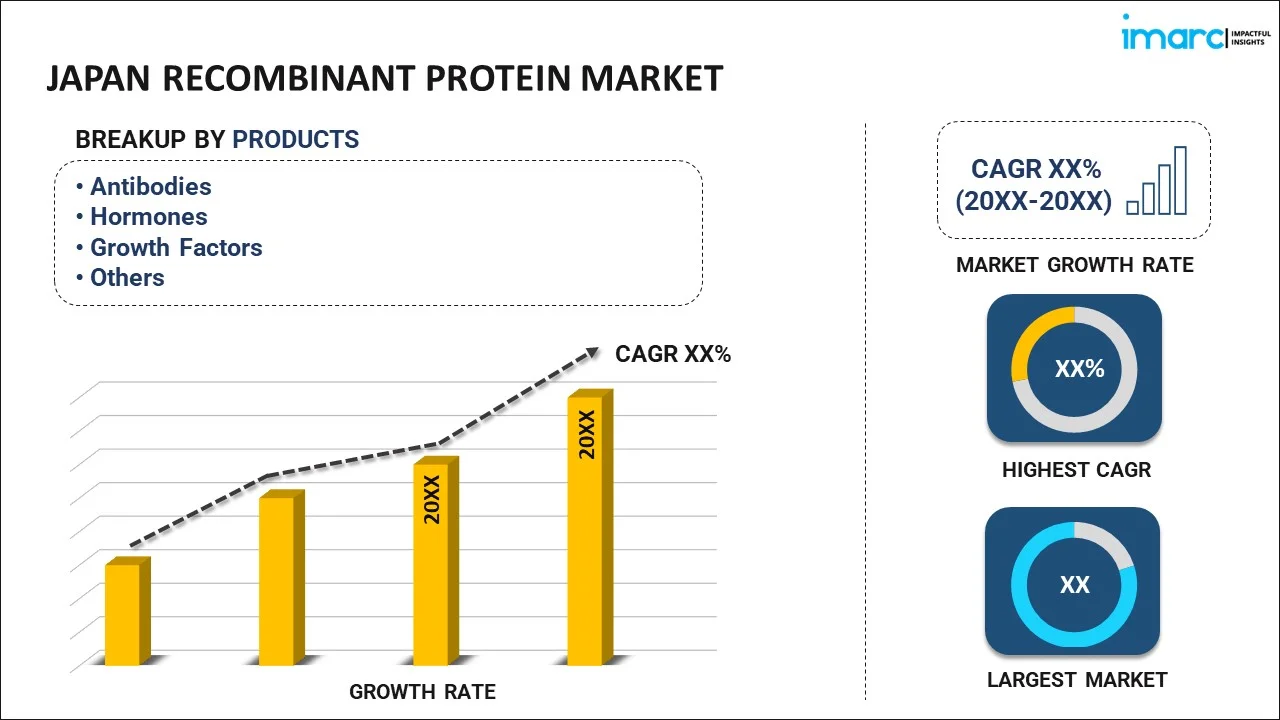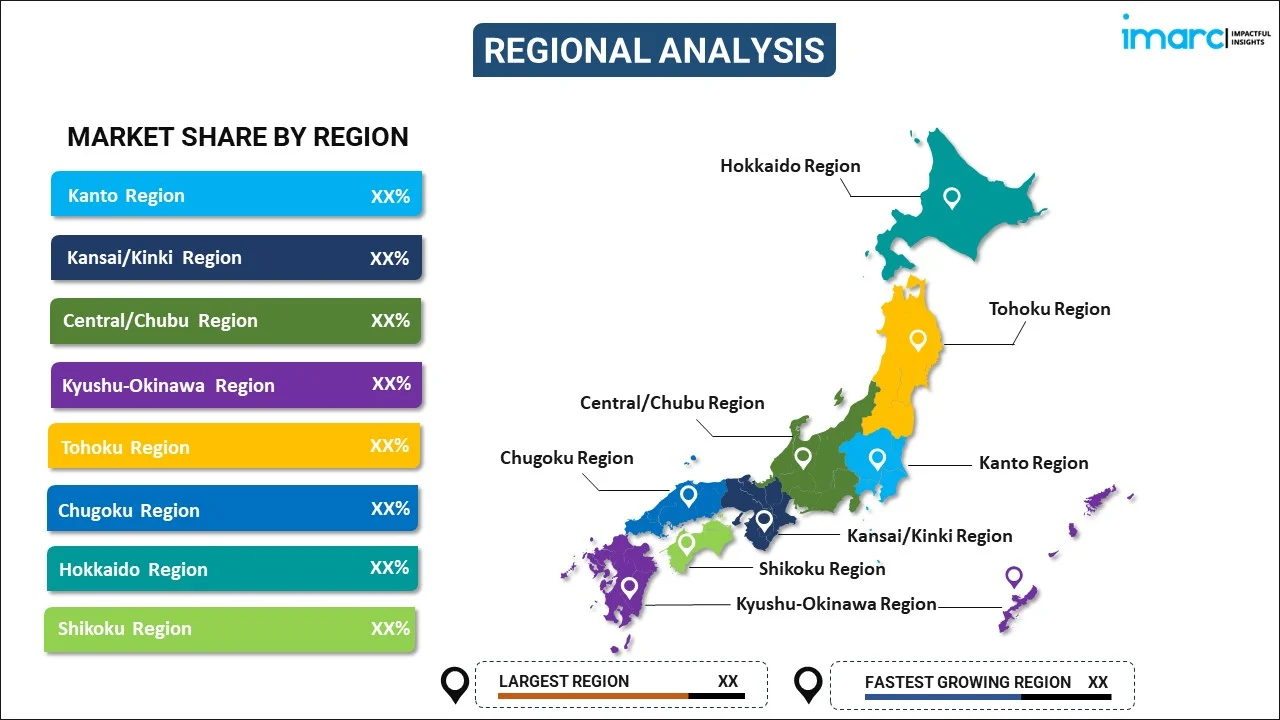
Japan Recombinant Protein Market Report by Product (Antibodies, Hormones, Growth Factors, Cytokines, and Others), Application (Drug Discovery and Development, Academic Research, Biotechnology Research, Biopharmaceutical Production, and Others), End User (Pharmaceutical and Biopharmaceutical Companies, Biotechnology Companies, Academic and Research Institutes, Contract Research Organization, and Others), and Region 2025-2033
Market Overview:
Japan recombinant protein market size reached USD 265.7 Million in 2024. Looking forward, IMARC Group expects the market to reach USD 573.7 Million by 2033, exhibiting a growth rate (CAGR) of 8.9% during 2025-2033. The inflating development of biopharmaceuticals, such as monoclonal antibodies, vaccines, and therapeutic proteins, which are increasingly being used to treat various illnesses, including cancer, autoimmune disorders, and infectious diseases, is driving the market.
|
Report Attribute
|
Key Statistics
|
|---|---|
|
Base Year
|
2024 |
|
Forecast Years
|
2025-2033 |
|
Historical Years
|
2019-2024
|
| Market Size in 2024 | USD 265.7 Million |
| Market Forecast in 2033 | USD 573.7 Million |
| Market Growth Rate (2025-2033) | 8.9% |
Recombinant protein are artificially engineered proteins created by combining genetic material from different sources, typically DNA from one organism with the ability to produce a specific protein and the host organism's cellular machinery for protein production. This process is integral to the biotechnology and pharmaceutical industries, allowing the large-scale production of specific proteins for various applications. To create recombinant proteins, scientists insert the desired gene sequence into a host organism, like bacteria, yeast, or mammalian cells. Once the host organism takes up the foreign DNA, it begins producing the target protein according to the inserted genetic instructions. Recombinant proteins have diverse applications, including the production of therapeutic drugs (e.g., insulin or vaccines), research tools (e.g., enzymes and antibodies), and industrial enzymes for various processes (e.g., biofuel production or food processing). Their production allows for precise control, scalability, and purity, making them essential in advancing medical, scientific, and industrial fields.
Japan Recombinant Protein Market Trends:
Several factors drive the recombinant protein market in Japan. Firstly, the increasing incidence of chronic diseases such as cancer, diabetes, and autoimmune disorders has created a growing demand for therapeutic proteins produced through recombinant DNA technology. Consequently, pharmaceutical companies are heavily investing in the development of novel biopharmaceuticals, propelling the market forward. Furthermore, advancements in genetic engineering and biotechnology have led to improved production processes for recombinant proteins. Enhanced expression systems, such as mammalian and yeast cell lines, have enabled the production of complex proteins with higher yields and better quality, driving market expansion. In addition to this, the surge in R&D activities in the field of proteomics and genomics has boosted the demand for recombinant proteins as research tools. These proteins are essential for studying gene function, protein-protein interactions, and drug discovery, fostering market growth. Moreover, the adoption of personalized medicine and the development of bi-specific antibodies and fusion proteins, which have opened up new opportunities in the therapeutic protein industry, is expected to drive the recombinant protein market in Japan during the forecast period.
Japan Recombinant Protein Market Segmentation:
IMARC Group provides an analysis of the key trends in each segment of the market, along with forecasts at the country level for 2025-2033. Our report has categorized the market based on product, application, and end user.
Product Insights:

- Antibodies
- Hormones
- Growth Factors
- Cytokines
- Others
The report has provided a detailed breakup and analysis of the market based on the product. This includes antibodies, hormones, growth factors, cytokines, and others.
Application Insights:
- Drug Discovery and Development
- Academic Research
- Biotechnology Research
- Biopharmaceutical Production
- Others
A detailed breakup and analysis of the market based on the application have also been provided in the report. This includes drug discovery and development, academic research, biotechnology research, biopharmaceutical production, and others.
End User Insights:
- Pharmaceutical and Biopharmaceutical Companies
- Biotechnology Companies
- Academic and Research Institutes
- Contract Research Organization
- Others
The report has provided a detailed breakup and analysis of the market based on the end user. This includes pharmaceutical and biopharmaceutical companies, biotechnology companies, academic and research institutes, contract research organization, and others.
Regional Insights:

- Kanto Region
- Kansai/Kinki Region
- Central/ Chubu Region
- Kyushu-Okinawa Region
- Tohoku Region
- Chugoku Region
- Hokkaido Region
- Shikoku Region
The report has also provided a comprehensive analysis of all the major regional markets, which include Kanto Region, Kansai/Kinki Region, Central/ Chubu Region, Kyushu-Okinawa Region, Tohoku Region, Chugoku Region, Hokkaido Region, and Shikoku Region.
Competitive Landscape:
The market research report has also provided a comprehensive analysis of the competitive landscape. Competitive analysis such as market structure, key player positioning, top winning strategies, competitive dashboard, and company evaluation quadrant has been covered in the report. Also, detailed profiles of all major companies have been provided.
Japan Recombinant Protein Market Report Coverage:
| Report Features | Details |
|---|---|
| Base Year of the Analysis | 2024 |
| Historical Period | 2019-2024 |
| Forecast Period | 2025-2033 |
| Units | Million USD |
| Scope of the Report | Exploration of Historical and Forecast Trends, Industry Catalysts and Challenges, Segment-Wise Historical and Predictive Market Assessment:
|
| Products Covered | Antibodies, Hormones, Growth Factors, Cytokines, Others |
| Applications Covered | Drug Discovery and Development, Academic Research, Biotechnology Research, Biopharmaceutical Production, Others |
| End Users Covered | Pharmaceutical and Biopharmaceutical Companies, Biotechnology Companies, Academic and Research Institutes, Contract Research Organization, Others |
| Regions Covered | Kanto Region, Kansai/Kinki Region, Central/ Chubu Region, Kyushu-Okinawa Region, Tohoku Region, Chugoku Region, Hokkaido Region, Shikoku Region |
| Customization Scope | 10% Free Customization |
| Post-Sale Analyst Support | 10-12 Weeks |
| Delivery Format | PDF and Excel through Email (We can also provide the editable version of the report in PPT/Word format on special request) |
Key Questions Answered in This Report:
- How has the Japan recombinant protein market performed so far and how will it perform in the coming years?
- What has been the impact of COVID-19 on the Japan recombinant protein market?
- What is the breakup of the Japan recombinant protein market on the basis of product?
- What is the breakup of the Japan recombinant protein market on the basis of application?
- What is the breakup of the Japan recombinant protein market on the basis of end user?
- What are the various stages in the value chain of the Japan recombinant protein market?
- What are the key driving factors and challenges in the Japan recombinant protein?
- What is the structure of the Japan recombinant protein market and who are the key players?
- What is the degree of competition in the Japan recombinant protein market?
Key Benefits for Stakeholders:
- IMARC’s industry report offers a comprehensive quantitative analysis of various market segments, historical and current market trends, market forecasts, and dynamics of the Japan recombinant protein market from 2019-2033.
- The research report provides the latest information on the market drivers, challenges, and opportunities in the Japan recombinant protein market.
- Porter's five forces analysis assist stakeholders in assessing the impact of new entrants, competitive rivalry, supplier power, buyer power, and the threat of substitution. It helps stakeholders to analyze the level of competition within the Japan recombinant protein industry and its attractiveness.
- Competitive landscape allows stakeholders to understand their competitive environment and provides an insight into the current positions of key players in the market.
Need more help?
- Speak to our experienced analysts for insights on the current market scenarios.
- Include additional segments and countries to customize the report as per your requirement.
- Gain an unparalleled competitive advantage in your domain by understanding how to utilize the report and positively impacting your operations and revenue.
- For further assistance, please connect with our analysts.
 Inquire Before Buying
Inquire Before Buying
 Speak to an Analyst
Speak to an Analyst
 Request Brochure
Request Brochure
 Request Customization
Request Customization




.webp)




.webp)












